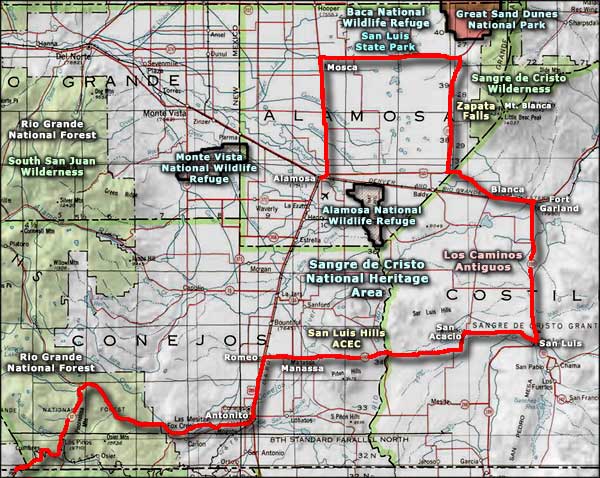Sangre de Cristo Wilderness

Upper Huerfano River Valley in the Sangre de Cristo Wilderness
Located in south-central Colorado and straddling the boundary between San Isabel and Rio Grande National Forests, the Sangre de Cristo Wilderness encompasses 228,044 acres of spectacular mountainscape in the Sangre de Cristo Mountains. Sangre de Cristo Wilderness is bordered on the east by the Wet Mountain Valley and on the west by the San Luis Valley. The towns of Salida (north), La Veta (south), Westcliffe (east), Saguache (west) and Crestone (west), all border this mountain range.
The majority of the mountain range is composed of Pennsylvanian-Permian rock (metamorphic and sedimentary) that was pushed up about 27 million years ago. The Blanca Massif area is older, composed of Pre-Cambrain granite emplaced more than 1.5 billion years ago. The whole of the range was extensively glaciated during the ice ages but the only permanent ice/snow field now is located at the bottom of the escarpment on the north side of Blanca Peak.
The Sangre de Cristo Wilderness is one of the youngest designated wilderness areas in Colorado. Designated in 1993, the area has over 60 alpine lakes, 400 miles of streams and nearly 400 miles of trails. Sangre de Cristo is Spanish for "Blood of Christ." According to legend, a Spanish Priest, Father Francisco, was mortally wounded by an Indian's arrow. In his dying moments, Father Francisco raised himself on his elbow, viewed the setting sun's red glow on the mountain range and gasped, "Sangre de Cristo."
By the time the Conquistadors arrived in the 16th and 17th centuries, Ute, Comanche, Navajo and Pueblo peoples lived in the region. For 250 years, Spanish and Indian farming communities maintained a tenuous existence in the San Luis Valley. To encourage frontier settlement, Spain, and later independent Mexico, granted enormous tracts of land to influential and enterprising citizens. Over 150 years later, the Sangre de Cristo and Luis Maria Baca Land Grants still remain somewhat intact (the Sangre de Cristo Grant has been whittled down a lot while most of the Baca Grant is now part of Baca National Wildlife Refuge, Great Sand Dunes National Park or Rio Grande National Forest).
In the 1870's and 1880's, American ranches and railroads flanked the Sangre de Cristo range. Over one million head of cattle and sheep grazed the San Luis, Huerfano and Wet Mountain Valleys, moving up into the high mountains for summer pasture. During this time, Rocky Mountain elk, bighorn sheep, and beaver nearly disappeared and grizzly bears were wiped clean from the mountains of Colorado. Between 1860 and 1910, fires were purposely set, burning most of the forest to increase summer sheep pastures, expose minerals or produce charcoal. The glorious aspen glades we see today owe their origins to this period of burning. In 1902 a major portion of the Sangre de Cristo's was set aside as the San Isabel Forest Reserve. The Reserve later became the San Isabel and Rio Grande National Forests, managed by the U.S. Forest Service. In 1993, Congress designated the Sangre de Cristo Wilderness to preserve and protect a large section of the most rugged and spectacular mountainous terrain.
In the heart of the Wilderness are Crestone Peak, Crestone Needle, Kit Carson Peak, and Humboldt Peak, four of Colorado's 54 14er's. In the area around these peaks you can expect to see heavy traffic nearly all year round (folks bagging peaks, ya know...) South of there in the Upper Huerfano Valley you'll come up close to 4 more 14er's (Blanca Peak, Ellingwood Point, Mt. Lindsey, and Little Bear) and see similar traffic problems. But once you get away from these particular peaks, the woods are pretty empty. There's a number of trails up into the mountains but most lead to high altitude lakes that sit below virtually unclimbable, glacier-carved walls. To say it's beautiful is to not do it justice. The Rainbow Trail skirts the wilderness area on the east side and there are many trails off that that lead into the heart of the mountains.
With increasing visitor use in the Sangre de Cristo Wilderness, the Forest Service is considering a self-issuing permit system. For more information, please contact the San Carlos Ranger District (719) 269-8500.

Related Pages
Baca National Wildlife Refuge
Great Sand Dunes National Park
Los Caminos Antiguos

